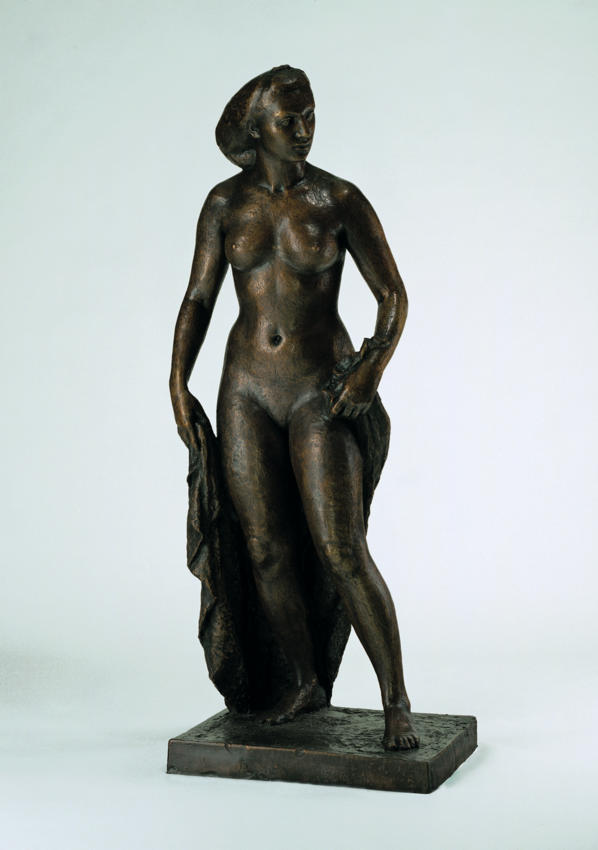We acknowledge the Traditional Owners of the land on which the Queensland Art Gallery | Gallery of Modern Art stands and recognise the creative contribution First Australians make to the art and culture of this country.

Daphne Mayo / Australia 1895–1982 / Susannah 1946, cast 1995 / Bronze / 171 x 65.5 x 51cm / Commissioned 1995 from a cast gifted by the beneficiaries of the artist’s estate 1981 with funds from the Queensland Art Gallery Society. Celebrating the Queensland Art Gallery’s Centenary 1895–1995 / Collection: Queensland Art Gallery | Gallery of Modern Art / © Surf Lifesaving Foundation and The United Church in Australia Property Trust (Q.)
Daphne MayoSusannah 1946–1995
Not Currently on Display
During the 1940s, Daphne Mayo produced a series of allegorical works depicting serenely classical women, inspired by the work of French sculptors Aristide Maillol (1861−1944) and Charles Despiau (1874−1946). These calm and strong figures possibly reflect Mayo’s own feelings about the role of women in contemporary society; independent and courageous, Mayo herself was the epitome of the modern, liberated woman.
The theme of ‘Susannah’, a Jewish heroine whose story is recounted in the Apocrypha, recurs in Mayo’s paintings and sculptures of this time. Susannah was the wife of a Babylonian who entertained many people, including two elders who had been appointed judges. Both lusted after Susannah and waited for an opportunity to find her alone, which they did when she took her bath.
In exploring this theme, Mayo depicted Susannah, not as a seductress as many artists had done, but as a model of virtue, resolute and defiant, as she discovers she is being watched.1 The exclusion of the elders from our view increases the impression of Susannah’s solitary strength.
Endnotes:
1. Judith McKay, Daphne Mayo: Let There Be Sculpture [exhibition catalogue], Queensland Art Gallery, Brisbane, 2011, p.26.
Born in Sydney, Daphne Mayo’s family moved to Brisbane when she was still a child. She studied art at Brisbane Technical College, where she was awarded the Wattle Day League Scholarship to study at the Royal Academy Schools in London. Mayo was the first woman to be admitted to the academy’s School of Sculpture for some years, and she achieved considerable success, winning a number of awards during her time there. On graduating in 1923, she was also awarded the school’s gold medal for sculpture, which earned her the Edward Stott Travelling Studentship prize of a trip to Italy.
On her return to Australia, Mayo received commissions to carve the tympanum over the portico of the Brisbane City Hall, and for war memorials in Anzac Square, Brisbane, and at The King’s School, Parramatta. With Vida Lahey, Mayo helped establish the Queensland Art Fund (1929) with the aim of acquiring major works for the Queensland Art Gallery’s Collection. She was awarded the medal of the Society of Artists and made a Member of the British Empire for services rendered to art.
Daphne Mayo was a great believer in making art publicly accessible, rejecting the idea that it could only be enjoyed by a cultural elite. In an interview in Brisbane’s Courier, dated 3 February 1933, she said: ‘Art is simply an integral part of everyone’s life. . .it enters every phase of daily life, in the dresses (they) wear, the cup (they) drink from, the rug on the floor. There is nothing in any home that is not some example of art, either good or bad’.
Discussion Questions
Try to identify how this sculpture connects with the paintings of women in the Australian collection. What is similar in terms of pose, presence and features?
Classroom Activities
Research Daphne Mayo’s life. Sketch images of her and her sculptures. Once you build a folio of drawings, plan and create a clay sculpture inspired by the artist’s life and work.